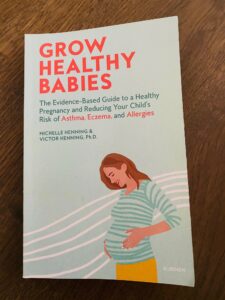 Being pregnant can feel like a minefield. Knowing what to eat and what to avoid can feel overwhelming. With allergies on the rise it adds more pressure. So I was excited to see the Grow Healthy Babies book. It is an evidence-based guide to reducing your child’s risk of asthma, eczema and allergies.
Being pregnant can feel like a minefield. Knowing what to eat and what to avoid can feel overwhelming. With allergies on the rise it adds more pressure. So I was excited to see the Grow Healthy Babies book. It is an evidence-based guide to reducing your child’s risk of asthma, eczema and allergies.
I was hoping it would not be a hippy-dippy book preaching to others what to eat and do, and I am happy to report it is not. It is a fantastic, well-researched book which backs up everything it says in droves. This book shows that you can make a huge difference to the health of your child, and it all starts in pregnancy. Pregnant women have more power than they realise.
While some of the research is not helpful to everyone- eating organic food is not within everyone’s range- I found the advice in this book invaluable. I would recommend it to anyone who is having a baby, or even thinking about getting pregnant. It is a truly great book and a triumph for the authors.
When lifelong asthma, eczema, and allergy sufferers Michelle Henning, a certified Nutrition & Health Coach, and her husband Dr. Victor Henning decided to become parents, they were well aware that half of all babies born today will develop allergies and up to a third will become asthmatic or suffer from eczema. Using their combined backgrounds in nutrition and science, they began investigating a mountain of medical literature on how to prevent chronic illness so that their baby would grow up healthy.
In their honest and enlightening new book Grow Healthy Babies, the Hennings share their research by distilling the latest medical evidence into a practical, easy to read guide that provides expecting parents with clear and simple steps to lower a baby’s risk of developing a chronic condition by up to 90%. With the goal of empowering parents-to-be or those planning to get pregnant with information about simple choices that improve their health and their child’s health, they cover a multitude of topics including:
- You can make a difference: By making different choices during/after pregnancy, you have the power to shape your baby’s health for life
- How your baby’s immune system develops, and how you can strengthen it to prevent chronic illness
- How friendly bacteria, your microbiome, shape both your and your baby’s health, and how to protect and improve your microbiome
- Which food choices and supplements during and after pregnancy make a real difference to your baby’s health, according to scientific studies
- Why environmental factors and certain household products can trigger chronic disease, and how to choose healthier alternatives
- How birth choices and breastfeeding can influence your baby’s long-term health
Grow Healthy Babies: The Evidence-Based Guide to a Healthy Pregnancy and Reducing Your Child’s Risk of Asthma, Eczema, and Allergies is available for pre-order at bookstores nationwide and online retailers such as Amazon.
